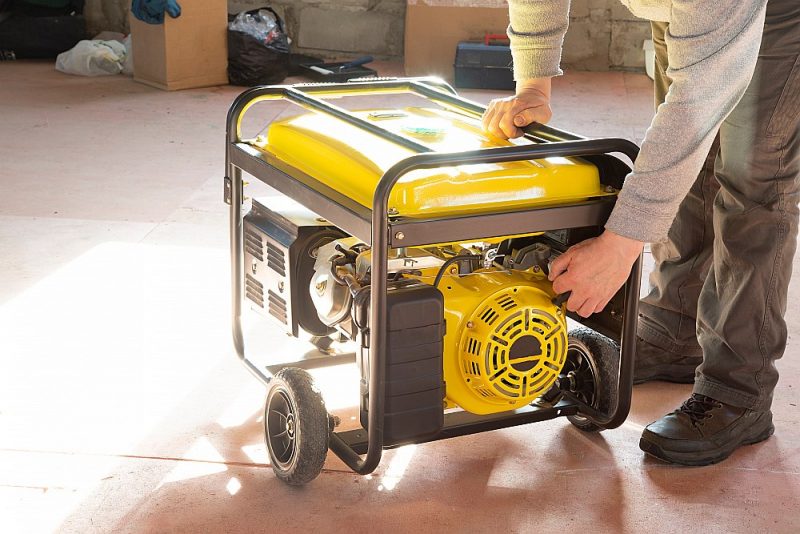
Many consumers affected by power outages caused by both natural disasters and grid outages have already purchased generators for some time. The most popular are mobile generators, which have a wide range of applications: they can be used both in private homes and on nature trips.
Photo: Potashev Aleksandr / SHUTTERSTOCK
Kristine Stepiņa, “Latvijas Avīze”, JSC “Latvijas Mediji”
Monika Zīle on the introduction of “Stability” to Saeima: “How is it ?!” “Yes, here it is – THAT!”
VIDEO. Chilling footage: Wolves enter the territory of a house in broad daylight in the Talsi region. The brave dog quarrels with predators
cut, kill them, burn them, tie them to a tree! The occupier’s girlfriend encourages atrocities against Ukrainian soldiers
Read other posts
The start of the synchronous operation of the energy supply systems of the Baltic countries with the European grids is scheduled for 2025. Given the unstable geopolitical situation, the disconnection of the Baltic states from the BREL circle initiated by Russia cannot be excluded.
Although the operator of the Latvian transmission system AS “Augstsprieguma tīkls” (“AST”) is ready for all scenarios of event development and, if necessary, the Baltic States are ready for emergency synchronization with Europe continental even before the deadline is set, residents and production companies are rushing to buy electricity generators.
The shops are empty, the prices are rising
Recently, the demand for electricity generators has increased significantly, currently only a couple of devices are available in the store, admits Aleksandrs Kokarevičs, the project manager of the largest electricity supplier “Energoluxs”. “The question is in waves. The first wave was when the war in Ukraine started.
The second, when the Prime Minister of Estonia called on the people to prepare for a power outage if Russia were to disconnect the Baltic states from the electricity grid. But the third is related to the sad situation in Ukraine related to the supply of electricity, because lately the Russian army has bombed more and more Ukraine’s electricity supply infrastructure.
Many Latvian residents have also bought generators to send them to Ukrainians as humanitarian aid, “A. Kokarevičs describes the market situation. He says that it is currently problematic to order generators from European factories, so it is difficult to schedule deliveries.” generators is huge, shoddy goods are appearing on the market. Prices have also skyrocketed. During this year they have increased by 20-30%. This is not only related to the high demand, but mainly to the fact that raw materials and delivery costs have become more expensive “, evaluates A. Kokarevičs.
The most requested are of the inventory type
Generators used both in households and in production are required. “As electricity prices are high, companies in some sectors have switched to diesel generators as the only source of electricity generation. For example, farms that have grain dryers that operate seasonally, but have to pay for connection to the grid throughout the year, “explains A. Kokarevičs.
The most requested are mobile generators, or generators, which have a very wide range of applications, can be used both in private homes, on nature trips, and to organize various outdoor events. They don’t take up much space and make no noise during the power generation process.
Most of them produce enough energy to provide interior lighting, operate a refrigerator and other electrical appliances, as well as a well water pump or heat pump. A 5-10 kilowatt generator is completely sufficient for a large number of private homes. “Inventory-type generators had already been purchased in the first two waves of demand.
Many of those who had planned to buy them earlier, but who for some reason have postponed the purchase this year, fearing the electricity crisis, have bought generators, “said A. Kokarevičs.
Switch to generator only, no cost reduction
Such a purchase is far from cheap. “When buying quality brand generators, households should expect costs ranging from 1,000 euros to 2.5 thousand euros. But for industrial companies – from six to 50 thousand euros. The price depends on the capacity of the equipment”, informs the representative of “Energolux”.
Andris Skrastiņš, customer manager of the home and industry tools shop “Verkter”, says that the range of generators currently on sale has been significantly reduced, only six different devices for generating electricity are offered, starting with 679 to 1,875 euros. Some are available for purchase now, but some have to wait several weeks as they are delivered from European manufacturers’ warehouses. However, the demand was significantly higher in the summer, A. Skrastiņš noted.
On the other hand, the executive director of the Latvian Association of Electrical Engineers and Power Builders, Gunārs Valdmanis, refutes the idea that at current electricity prices it is more profitable to switch completely to generating electricity with generators. “It will not be cheaper. If we assume that the price of diesel is two euros, the energy capacity is 10 kilowatt hours (kWh) and the efficiency factor is about 40%, the cost of one kWh will be 0.50 EUR / kWh, which is about three times more than the current price of electricity on the exchange. The cost of purchasing the generator and depreciation have yet to be calculated, “explains the energy expert.
There is no reason to panic
Ivars Kronenbergs, head of the systems management department of “AST”, informs that the synchronization process with continental Europe will last from six to 24 hours, during which the Baltic countries will work in isolated mode or in island mode.
“During this period of time, the capacities generated locally in each of the countries will meet the full consumption of the country. In Latvia, the generation capacities are sufficient to guarantee work in isolated mode and most likely the users of the system will not feel the transition from one zone synchronous to another. In the event of planned and emergency synchronization, consumer outages are not planned, so there should be no reason for consumers to equip themselves with electricity generators. Of course, power outages cannot be completely ruled out short-term or voltage fluctuations in the grid, “said I. Kronenberg.
In recent history, the storm of 2005 can be cited as the most significant outages, affecting 60% of electricity consumers. At that time, there were many faults in the power grids in the larger territory of the country, they could not be repaired immediately, due to a lack of both human and technical resources.
On the other hand, in the summer of 2020, due to the interruption of the 330 kV cable line in Riga, the right bank of the Daugava, as well as several neighboring areas up to Limbaži, remained without electricity for a few hours. Many consumers affected by power outages caused by both natural disasters and grid outages have already purchased generators for some time. They do not regret their investments in alternative power generation devices, even in situations where they have never had to use them. “Better an acorn in hand than a hunter in a tree”, perhaps this proverb is right this time.
Themes


